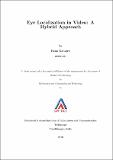Eye localization in video: a hybrid approach
Abstract
Location of eyes is an important process for operations such as orientation correction, which are necessary pre-processes for face recognition. As eyes are one of the main features of the human face, the success of facial feature analysis and face recognition depends greatly on eye detection. It is advantageous to detect eyes before other facial features because the position of other facial features can be estimated using eye position and golden ratio. Since relative position of eyes and interocular distance are nearly constant for different individuals, eye localization is also useful in face normalization. Hence, eye localization is a very important component for any face recognition system.
Various approaches to eye localization have been proposed and can be classified as feature based approaches, template based approaches and appearance based approaches. Feature based methods explore eye characteristics - such as edge and intensity of iris - to identify some distinctive features around the eyes. In template based methods, a generic model of eye shape is designed; this template is then matched to the face image pixel by pixel to find the eyes. Appearance based methods detect eyes based on their photometric appearance. Template based and appearance based methods can detect eyes accurately but they are not efficient when considering time factor while feature based methods are efficient but do not give accurate results. So, by combining feature based method with template based or appearance based method, we can get better results. In the proposed algorithm, we have combined feature based eye LEM approach proposed by Mihir Jain, Suman K. Mitra, Naresh D. Jotwani in 2008 and appearance based Bayesian classi_er approach proposed by Everingham M., Zisserman A. in 2006 to achieve eye localization.
The work of localizing eyes in a video is motivated by some of the applications where eye localization can serve very useful purpose such as to find drowsiness of a person driving a car, eye based control of computer systems for people with motor difficulties. To carry out eye localization, after doing some preprocessing which include frame separation from video and to convert it into gray-scale images, the proposed algorithm is applied on each of these frames. For the experimentation, we have taken videos of few people in the normal blink condition as well as in the sleepy condition. All the videos have been taken in the lab environment. To check the accuracy of the proposed algorithm, we have performed various tests, namely, Wilcoxon signed rank test, Mann-Whitney U test, Kolmogorov-Smirnov test, Sensitivity and False alarm rate tests. And the results of these tests show that the proposed algorithm proves to be quite accurate in localizing the eyes in a video. All the experiments have been carried out in MATLAB.
Collections
- M Tech Dissertations [923]

